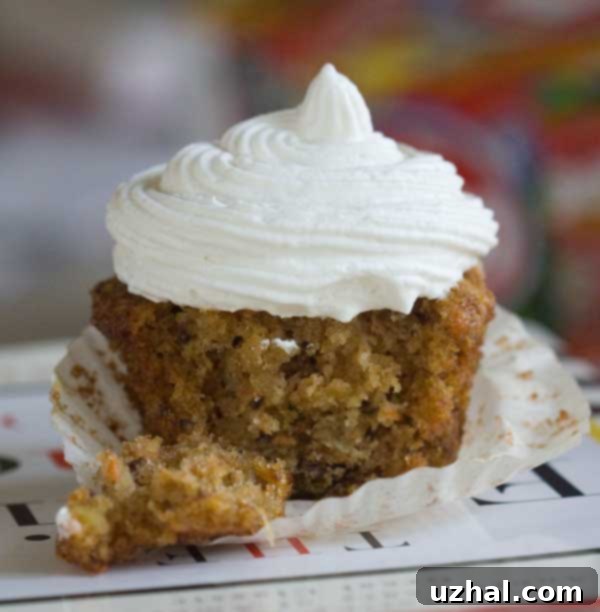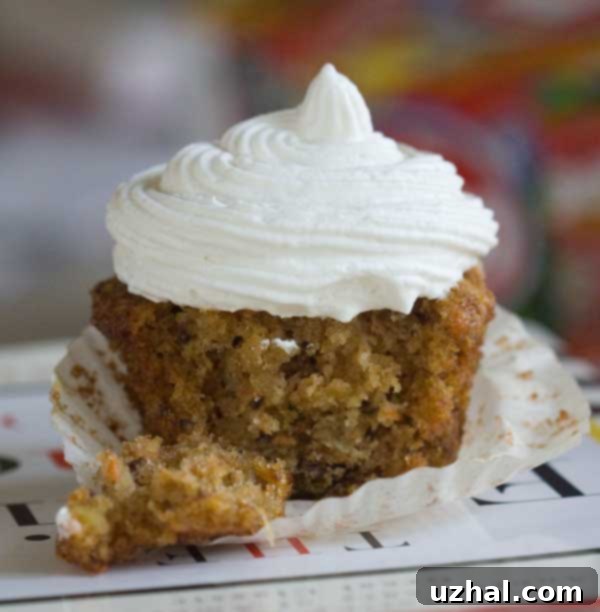Perfectly Moist & Crumbly Rabbit’s Carrot Cake Cupcakes: A Beloved Fanny Farmer Adaptation
Embark on a culinary journey to baking perfection with these exquisite Rabbit’s Carrot Cake Cupcakes. This cherished recipe is a refined adaptation of “Rabbit’s Carrot Cake” from the classic *The Fanny Farmer Cookbook*, carefully tweaked and tested in my ongoing quest to discover the ultimate carrot cupcake. The results, I’m thrilled to report, are nothing short of spectacular. Unlike some overly wet or dense carrot cakes, these cupcakes boast a rich brown hue, a delightful crumbliness, and an impeccable moistness that is never mushy. Their deep flavor and satisfying texture fondly echo the high-quality carrot cupcakes found at my favorite local shop, Sugar Mama’s, offering a homemade version that stands proudly alongside bakery treats.
The Quest for Texture: Crumbly, Not Mushy
One of the most significant revelations throughout my extensive carrot cake experimentation has been the critical role of leavening agents in achieving that ideal texture. Many traditional carrot cake recipes often call for a generous amount of baking soda – sometimes as much as two teaspoons. However, I’ve consistently found that employing a balanced combination of both baking powder and baking soda yields a distinctly crumblier, more desirable texture compared to relying solely on baking soda.
The science behind this, as highlighted by Cook’s Illustrated, is quite fascinating. Baking soda, being an alkaline agent, increases the pH of the batter. This alkalinity can cause the cell walls of the grated carrot pieces to break down, releasing their moisture and essentially leaking carrot juice into the batter. Cook’s Illustrated vividly compares this effect to a plastic bag filled with water that gets punctured, allowing its contents to escape. This breakdown often leads to a denser, sometimes almost mushy texture in the final baked good.
My hypothesis is that the inclusion of baking powder helps to maintain a slightly more acidic environment within the batter. This acidity, in turn, may lessen the severity of the carrot cell wall breakdown, preventing excessive moisture release and preserving the structural integrity of the cake. The result is a lighter, more open crumb that truly lives up to the promise of a “crumbly” carrot cake. It’s this careful balance of leavening that makes Rabbit’s Carrot Cake Cupcakes so exceptionally good, offering a texture that is both tender and resilient.
Ingredients Matter: The Heart of a Great Cupcake
Every ingredient in Rabbit’s Carrot Cake Cupcakes plays a vital role in crafting their unforgettable flavor and texture. Let’s explore some of the key components:
The Carrots: Freshness and Preparation
The star of the show, carrots, are best when freshly grated. While pre-shredded carrots from the grocery store might save a minute, they often lack the same moisture and vibrant flavor as those grated at home. Using a standard box grater or a food processor with a grating attachment will yield fine shreds that integrate beautifully into the batter, ensuring even distribution and maximum carrot flavor. The specified 1 ½ cups (170 grams) is the perfect amount to provide substantial carrot goodness without overwhelming the cake.
Lemon Juice & Pineapple: The Moisture and Tang Duo
The addition of lemon juice, typically 2 tablespoons, might seem subtle, but it’s crucial. It brightens the overall flavor profile of the carrots and pineapple, providing a lovely hint of acidity that cuts through the sweetness. The canned crushed pineapple, measured at ½ cup and thoroughly drained dry, adds another layer of moisture and tropical sweetness. Draining it well is paramount to prevent an overly wet batter, allowing it to contribute flavor and tender chewiness without making the cupcakes soggy.
Flour & Sugars: The Foundation of Flavor and Structure
A mix of all-purpose flour (1 ½ cups or 200 grams), granulated sugar (1 cup or 200 grams), and dark brown sugar (3 tablespoons, tightly packed, or 45 grams) forms the structural and sweet backbone. The combination of sugars is particularly important: granulated sugar provides sweetness and crispness, while dark brown sugar introduces a deeper, molasses-rich flavor and extra moisture, contributing to the cake’s desirable brown color and tenderness. As a note, if you prefer not to use brown sugar, you can substitute ¼ cup granulated sugar, or 4 tablespoons of light brown sugar for the 3 tablespoons of dark brown.
Leavening & Spices: The Magic Behind the Rise and Aroma
As discussed, the synergy of 1 teaspoon baking powder and 1 teaspoon baking soda is key to the crumbly, moist texture. Salt (1 teaspoon) balances the sweetness and enhances all the other flavors. And of course, no carrot cake is complete without cinnamon. This recipe calls for a generous 2 ½ teaspoons, ensuring a warm, aromatic spice profile that is central to carrot cake’s appeal. While other spices like nutmeg, ginger, or cloves could be added for personal preference, the prominent cinnamon flavor in this recipe truly shines.
Fats & Eggs: Richness and Binding
The combination of 6 tablespoons melted and cooled unsalted butter with 6 tablespoons neutral vegetable oil provides a perfect blend of flavor and moisture. Butter contributes a rich, classic taste, while vegetable oil ensures a supremely moist crumb that stays tender for longer. Three large eggs act as both binder and leavening support, contributing to the cake’s structure and richness.
Raisins & Walnuts: The Essential Add-ins
Finally, the add-ins: 1 cup golden raisins (or a mix of golden and brown) and 1 cup walnuts, toasted and chopped after measuring. Golden raisins offer a sweet, slightly tart chewiness, while toasted walnuts provide a delightful crunch and nutty depth. Toasting the walnuts beforehand is a small step that makes a big difference, intensifying their flavor and aroma, elevating the overall experience of these cupcakes.
The Perfect Partner: Cream Cheese Frosting
While a specific cream cheese frosting recipe isn’t included in the card, no carrot cake cupcake is truly complete without its classic counterpart. The ideal cream cheese frosting should strike a harmonious balance between tangy and sweet, offering a creamy, smooth texture that complements the spiced cake without being overly rich or cloying. There are countless excellent recipes available, but my personal preference leans towards those that feature a higher ratio of cream cheese to sugar.
This preference isn’t just about reducing sweetness; it’s about maximizing the distinctive tangy flavor of cream cheese, which beautifully cuts through the richness of the carrot cake. A good cream cheese frosting should be thick enough to pipe or spread elegantly, yet soft enough to melt delightfully in your mouth. Look for recipes that use full-fat cream cheese for the best body and flavor, and softened butter (not melted!) to ensure a smooth, stable emulsion. A splash of vanilla extract and sometimes a tiny pinch of salt can further enhance the flavor. Experimentation is key to finding your own perfect frosting, but generally, less sugar and more cream cheese is a winning formula for a truly exceptional topping.
More Delicious Recipes from Our Kitchen
If you enjoyed these carrot cake cupcakes, be sure to explore more delightful recipes from our collection:
- Rabbit’s Carrot Cake Loaves
- Fanny Farmer Chocolate Chip Cookies
- Cooked Oatmeal Muffins
- Saucepan Chocolate Cake
- The Farm Brownies aka Bake Ahead Brownies
Recipe

Rabbit’s Carrot Cake Cupcakes
Anna
Pin Recipe
Ingredients
- 1 ½ cups grated carrots (170 grams)
- 2 tablespoons lemon juice
- ½ cups canned crushed pineapple drained dry
- 1 ½ cups all-purpose flour (200 grams)
- 1 cup granulated sugar (200 grams)
- 3 tablespoons tightly packed dark brown sugar** (45 grams)
- 1 teaspoon baking powder
- 1 teaspoon baking soda
- 1 teaspoon salt
- 2 ½ teaspoons cinnamon
- 6 tablespoons unsatled butter, melted and cooled (84 grams)
- 6 tablespoons neutral vegetable oil
- 3 large eggs
- 1 cup golden raisins or a mix of golden and brown
- 1 cup walnuts toasted and chopped after measuring
Instructions
-
Preheat the oven to 350 degrees F. Line 22 to 24 cupcake cups or grease and flour two 8 ½ by 4 ½ inch loaf pans.
-
In a small bowl, mix carrots, lemon juice, and pineapple. Set aside.
-
In the bowl of your food processor (or just use a bowl), combine flour, both sugars, baking powder, baking soda, salt and cinnamon. Pulse to mix, then add butter, oil, and eggs, one by one until mixed. Add carrot mixture and pulse until mixed, then add the raisins and walnuts and pulse lightly just to mix or just stir with a rubber spatula.
-
Divide evenly among the cupcake cups, filling a little over ¾ cup full, or divide among two loaf pans. Bake cupcakes for about 25 minutes or loaves for about 45 minutes.
Notes
Baking Tips for Success
- Don’t Overmix: After adding the wet ingredients to the dry, mix just until combined. Overmixing can develop the gluten in the flour too much, leading to tough cupcakes. A few lumps are perfectly fine!
- Measure Accurately: Especially with flour, spoon it into your measuring cup and level it off with a straight edge rather than scooping directly from the bag. This prevents excess flour, which can dry out your cupcakes.
- Room Temperature Eggs: While this recipe calls for adding eggs to a food processor mix, generally, room temperature eggs incorporate more evenly into batter, creating a smoother texture.
- Toasting Walnuts: Don’t skip this step! Toasted walnuts have a much deeper, more intense flavor than raw ones, adding an extra layer of deliciousness to your cupcakes. Spread them on a baking sheet and toast at 350°F (175°C) for 5-7 minutes, watching carefully to prevent burning.
- Check for Doneness: Cupcakes are ready when a wooden skewer or toothpick inserted into the center comes out clean or with a few moist crumbs attached. Avoid overbaking, which can dry them out.
- Cool Completely: Always allow cupcakes to cool completely on a wire rack before frosting. Frosting warm cupcakes will cause the frosting to melt and slide off.
Storage and Serving Suggestions
Once baked and frosted, these Rabbit’s Carrot Cake Cupcakes are best stored in an airtight container in the refrigerator for up to 3-4 days, especially if topped with cream cheese frosting. Allow them to come to room temperature for about 15-20 minutes before serving for the best flavor and texture. These cupcakes are perfect for any occasion, from casual family gatherings to elegant dessert spreads, and they always disappear quickly!
I genuinely hope you enjoy baking and savoring these delightful carrot cake cupcakes as much as I do. They are a testament to the timeless appeal of classic recipes, thoughtfully refined for modern palates. Whether you’re making them for a special event or simply to brighten an ordinary day, these moist, crumbly, and richly spiced treats are sure to become a beloved favorite in your own kitchen.
